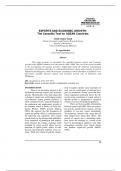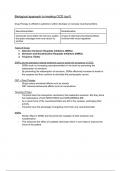Jurnal
EKONOM I
PEM BANGUNAN
Kajian Ekonomi Negara Berkembang
H al: 89 – 95
EXPORTS AND ECONOMIC GROWTH:
The Causality Test for ASEAN Countries
Abdul Ghafar Ismail
Islamic Economics and Finance Research Group
Faculty of Economics
Universiti Kebangsaan Malaysia
D. Agus Harjito
Universitas Islam Indonesia
Abstract
This study proposes to investigate the causality between exports and economic
growth in the ASEAN countries over the periods 1966 –2000. The role of the export variable
in the investigation of economic growth is emphasized. Using the Johansen cointegration
procedures test indicate that there is cointegration between export and economic growth in
Indonesia and Singapore, while the Granger causality test shows that there is feedback or bi-
directional causality between exports and economic growth only in Indonesia and
Philippines.
JEL classification: C22; F14; F43;
Keywords: export; economic growth; cointegration; causality test.
INTRODUCTION ition in exports markets cause economies of
There is an increasing interest in the scale and an acceleration of technical pro-
relationship between export and economic gress in production. Fourth, given the theo-
growth. Theoretically, it has been argue that retical arguments mentioned above, the ob-
a change in export rates could change output served strong correlation of export and pro-
of production. Export growth, therefore, is duction growth is interpreted as empirical
often considered to be a main determinant of evidence in favour of the ELG hypothesis.
the production and employment growth of There are three possible relationships
an economy which is shown in Gross Do- between exports and GDP. These are export-
mestic Product (GDP) growth (Ramos, led growth, growth-driven exports, and the
2001). He suggests that the hypothesis of feedback of two-way causal relationship.
export-led growth (ELG) is substantiated by The exporting countries with a large share of
the following four arguments. First, export their output grow faster than others. The
growth leads, by the foreign trade multiplier, growth of exports has a stimulating influ-
to an expansion of production and employ- ence across the economy as a whole in the
ment. Second, the foreign exchange made form of technological spillovers and other
available by export growth allows the im- externalities considers how export shocks
portation of capital goods, which, in turn, can produce export-led growth (Buffie,
increase the production potential of an eco- 1992).
nomy. Third, the volume of and the compet-
89
, Jurnal Ekonomi Pembangunan Vol. 8 No. 2, Desember 2003 Hal: 89 – 95
In contrast to the export-led growth causality for the sub-period 1952-1978.
hypothesis, scholars have noted that an in- Ahmed and Kwan (1991) found no causal
crease in GDP generally leads to a corres- link from exports to growth in cross section
ponding expansion of trade, unless the pat- study of 47 African countries, and weak evi-
tern of growth-induced supply and corres- dence of causality from economic growth to
ponding demand creates an anti-trade bias. exports, using data for the period 1981-
Recently, the most interesting economic 1987. Amoateng and Amoaku-Adu (1996)
scenarios suggest a two-way causal relation- found that there was feedback or bi-direc-
ship between growth and trade. Increased tional causality between external debt ser-
trade produces more income (increased vicing, economic growth and exports of 35
GDP), and more income facilitates more African countries. Ahmad and Harnhirun
trade- the result being like a “virtuous cir- (1995) found that only Singapore exists a bi-
cle”. Therefore, the aim of this paper is to directional, feedback relationship between
forward an additional evidence on those exports and economic growth in ASEAN
hypotheses using the ASEAN data. countries. Thornton (1995) found that real
The paper is organized as follows. In exports and real GDP in Mexico over 1895-
the following section contains literature re- 1992 were cointegrated and there was a sig-
view. In section 3, the methodology and the nificant and positive Granger-causal rela-
data are presented. Section 4 presents the tionship running from exports to economic
empirical results, and in the last section, growth. More recently, Ramos (2001) re-
conclusions and implications are presented. ported that there was a feedback effect be-
tween exports-output growth and imports-
LITERATURE REVIEW output growth in the Portuguese economy
Several recent empirical studies that over 1865-1998.
use Granger-type causality tests have not The purpose of this paper is to inves-
been particularly supportive of a positive tigate the relationship between exports and
causal relation running from export to eco- economic growth (GDP) in the ASEAN
nomic growth. For examples, Jung and Mar- countries, namely Indonesia, Singapore,
shall (1985) run such tests on data for 37 Malaysia, Thailand, and the Philippines over
developing countries for the period 1951- the period 1966-2000. These countries are
1981. They found evidence of unidirectional employed because, like other countries in
exports to growth causality for only four Asia, they have pursued aggressive export
countries. Exports-lead-growth causality only promotion policies and some have witnessed
appears in one country out of eight newly rapid economic growth. In order to test for
industrializing economics, bi-directional the existence of a long run or trend relation-
causality for six, and no causal link for one ship between exports and GDP, the theory of
(Chow, 1987). Further, Hsiao (1987) shown causality and cointegration developed by
that Granger tests causality confirmed no Engle and Granger (1987) and Johansen
causal relation between exports and GDP for (1988) will be applied.
four Asian newly industrializing economies,
except Hong Kong, where unidirectional METHODOLOGY AND DATA
causality run from GDP to exports. This study employs Engle’s and
Other researchers, like Kwan and Granger’s causality test to analyse the rela-
Cotsomotis (1991) found bi-directional cau- tionship between exports and economic
sality between exports and economic growth growth (GDP growth). Engle and Granger
in China for the period 1952-1988 and no (1987) show that when time series are cha-
90






